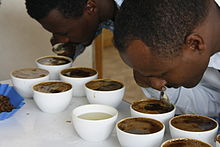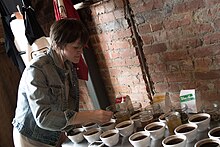Aromas

Various descriptions are used to note coffee aroma.[2]
- Animal-like – This odour descriptor is somewhat reminiscent of the smell of animals. It is not a fragrant aroma like musk but has the characteristic odour of wet fur, sweat, leather, hides or urine. It is not necessarily considered as a negative attribute but is generally used to describe strong notes. These flavors can be present in poor-quality dry process coffees.
- Ashy – This odour descriptor is similar to that of an ashtray, the odour of smokers' fingers or the smell one gets when cleaning out a fireplace. It is not used as a negative attribute. Generally speaking this descriptor is used by the tasters to indicate the degree of roast.
- Burnt/Smoky – This odour and flavour descriptor is similar to that found in burnt food. The odour is associated with smoke produced when burning wood. This descriptor is frequently used to indicate the degree of roast commonly found by tasters in dark-roasted or oven-roasted coffees.
- Chemical/Medicinal – This odour descriptor is reminiscent of chemicals, medicines and the smell of hospitals. This term is used to describe coffees having aromas such as rio flavour, chemical residues or highly aromatic coffees which produce large amounts of volatiles.
- Chocolate-like – This aroma descriptor is reminiscent of the aroma and flavour of cocoa powder and chocolate (including dark chocolate and milk chocolate). It is an aroma that is sometimes referred to as sweet.
- Caramel – This aroma descriptor is reminiscent of the odour and flavour produced when caramelizing sugar without burning it. Tasters should be cautioned not to use this attribute to describe a burning note.
- Cereal/Malty/Toast-like – This descriptor includes aromas characteristic of cereal, malt, and toast. It includes scents such as the aroma and flavour of uncooked or roasted grain (including roasted corn, barley or wheat), malt extract and the aroma and flavour of freshly baked bread and freshly made toast. This descriptor has a common denominator, a grain-type aroma. The aromas in this descriptor were grouped together since tasters used these terms interchangeably when evaluating standards of each one.
- Earthy – The characteristic odour of fresh, wet soil or humus. Sometimes associated with moulds and reminiscent of raw potato flavour, a common flavour note in coffees from Asia.
- Floral – This aroma descriptor is similar to the fragrance of flowers. It is associated with the slight scent of different types of flowers including honeysuckle, jasmine, dandelion and nettles. It is mainly found when an intense fruity or green aroma is perceived but rarely found having a high intensity by itself.
- Fruity/Citrussy – This aroma is reminiscent of the odour and taste of fruit. The natural aroma of berries is highly associated with this attribute. The perception of high acidity in some coffees is correlated with the citrus characteristic. Tasters should be cautioned not to use this attribute to describe the aroma of unripe or overripe fruit.
- Grassy/Green/Herbal – This aroma descriptor includes three terms which are associated with odours reminiscent of a freshly mown lawn, fresh green grass or herbs, green foliage, green beans or unripe fruit.
- Nutty – This aroma is reminiscent of the odour and flavour of fresh nuts (distinct from rancid nuts) and not of bitter almonds.
- Rancid/Rotten – This aroma descriptor includes two terms which are associated with odours reminiscent of rancidification and oxidation of several products. Rancid as the main indicator of fat oxidation mainly refers to rancid nuts and rotten is used as an indicator of deteriorated vegetables or non-oily products. Tasters should be cautioned not to apply these descriptors to coffees that have strong notes but no signs of deterioration.
- Rubber-like – This odour descriptor is characteristic of the smell of hot tyres, rubber bands and rubber stoppers. It is not considered a negative attribute but has a characteristic strong note highly recognisable in some coffees.
- Spicy – This aroma descriptor is typical of the odour of sweet spices such as cloves, cinnamon and allspice. Tasters are cautioned not to use this term to describe the aroma of savoury spices such as pepper, oregano and Indian spices.
- Tobacco – This aroma descriptor is reminiscent of the odour and taste of tobacco but should not be used for burnt tobacco.
- Winey – This terms is used to describe the combined sensation of smell, taste and mouthfeel experiences when drinking wine. It is generally perceived when a strong acidic or fruity note is found. Tasters should be cautioned not to apply this term to a sour or fermented flavour.
- Woody – This aroma descriptor is reminiscent of the smell of dry wood, an oak barrel, dead wood or cardboard paper.
